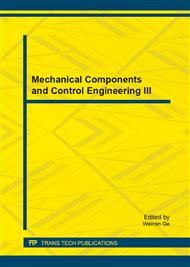[1]
B. Pang, L. Lee. Foundations and trends in information retrieval, 2008, 2(1-2): 1-135.
Google Scholar
[2]
Minqing Hu and B. Liu. Mining and Summarizing Customer Reviews. Proceedings of the ACM SIGKDD, Aug 22-25, 2004, Seattle, Washington, USA.
Google Scholar
[3]
S. Blair-Goldensohn, K. Hannan, R. McDonald, et al. Building a sentiment summarizer for local service reviews[C]/WWW Workshop on NLP in the Information Explosion Era. 2008: 14.
Google Scholar
[4]
A. Andreevskaia and S. Bergler. Mining WordNet for a fuzzy sentiment: Sentiment tag extraction from WordNet glosses. Proceedings of the European Chapter of EACL, (2006).
Google Scholar
[5]
A. Esuli and F. Sebastiani. PageRanking WordNet synsets: An application to opinion mining. in Proceedings of the Association for Computational Linguistics (ACL), (2007).
Google Scholar
[6]
J. Kamps, M. Marx, R. Mokken and M. de Rijke. Using WordNet to measure semantic orientation of adjectives. In Proc. Of LREC-2004, pp: 1115-1118, (2004).
Google Scholar
[7]
S. -M. Kim and E. Hovy. Determining the sentiment of opinions. Proceedings of the International Conference on Computational Linguistics (COLING), (2004).
DOI: 10.3115/1220355.1220555
Google Scholar
[8]
Peter D. Turney. Thumbs up or thumbs down? Semantic orientation applied to unsupervised classification of reviews. In Proceedings of the 40th ACL, pp: 417-424, (2002).
DOI: 10.3115/1073083.1073153
Google Scholar
[9]
S. Banerjee and T. Pedersen. An Adapted Lesk Algorithm for Word Sense Disambiguation Using WordNet. Proceedings of the Fourth International CICLING. Mexico City, Mexico, (2002).
DOI: 10.1007/3-540-45715-1_11
Google Scholar
[10]
W. Hui and M. Jun. Journal of computational information systems, 2012, 8(16): 6569-6577.
Google Scholar
[11]
B. Liu, Minqing Hu and Junsheng Cheng. Opinion Observer: Analyzing and Comparing Opinions on the Web. Proceedings of the WWW-2005, May 10-14, 2005, Chiba, Japan.
DOI: 10.1145/1060745.1060797
Google Scholar
[12]
Theresa Wilson, Janyce Wiebe and Paul Hoffmann. Recognizing Contextual Polarity in Phrase-Level Sentiment Analysis. Proceedings of HLT/EMNLP 2005, Vancouver, Canada.
DOI: 10.3115/1220575.1220619
Google Scholar


